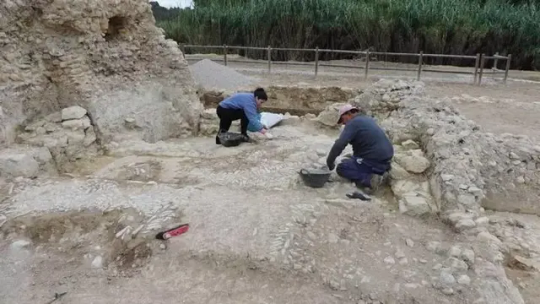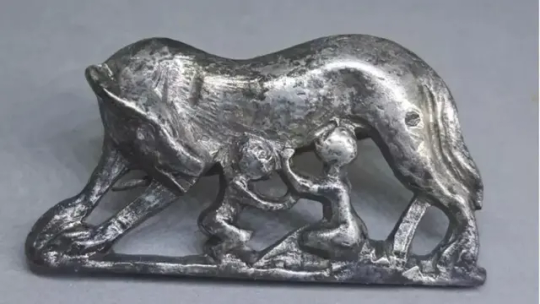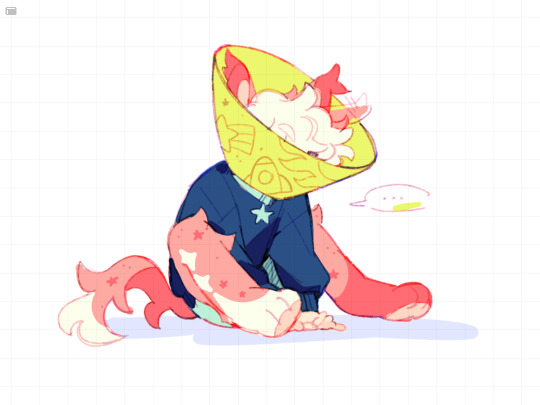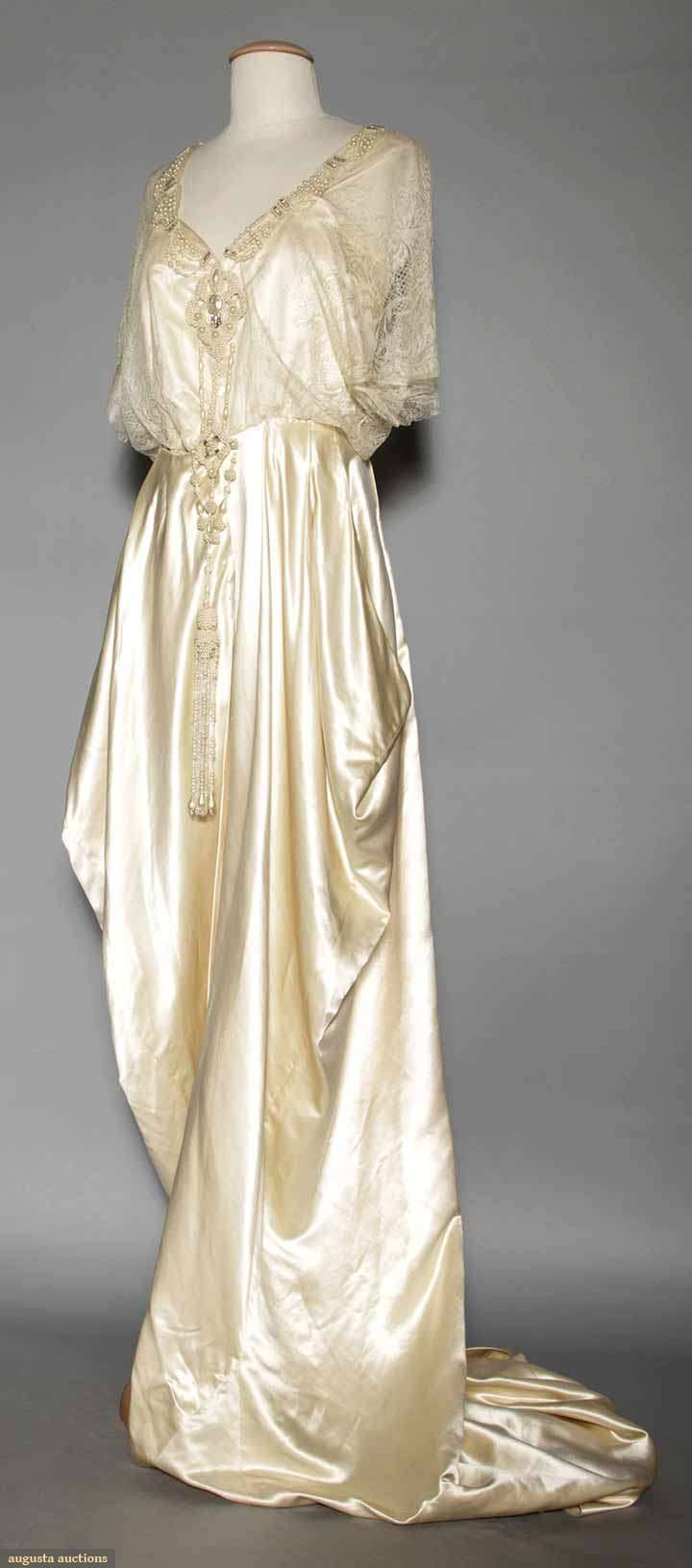#via Augusta
Explore tagged Tumblr posts
Text

Ancient Roman Silver Brooch of Romulus and Remus Found in Spain
The Department of Culture of the Generalitat Valenciana has recently announced the discovery of a rare silver brooch, depicting the iconic scene of Romulus and Remus being suckled by a she-wolf.
This remarkable artifact was discovered during excavations at Vilanova d’Alcolea, a site in Spain believed to have served as an ancient postal building during the Roman era. Archaeologists, led by Josep Carbó, made the discovery, describing it as an exceptional piece both for its rarity and quality.
Romulus and Remus, pivotal figures in Roman mythology, were twin brothers whose legendary tale forms the foundation myth of Rome and the Roman Kingdom. Born in Alba Longa to Rhea Silvia, the twins were the grandsons of the deposed King Numitor. Threatened by their potential claim to power, King Amulius, Numitor’s brother, ordered the infants to be abandoned on the banks of the Tiber River.
Legend has it that the twins were saved by a she-wolf who nursed them in a cave known as Lupercal, situated at the southwestern foot of the Palatine Hill in Rome. Upon discovering their true heritage, Romulus and Remus avenged their family and reinstated their grandfather, Numitor, as the rightful king. However, their story took a tragic turn when a dispute arose between the brothers, leading to Romulus committing fratricide against Remus. Romulus then went on to establish the city of Rome, solidifying his position as its first ruler.

The silver brooch, measuring 4 centimeters in size and dating back to the 2nd century CE, portrays the iconic scene of the she-wolf nurturing the twins in their infancy. This depiction has become synonymous with the founding of Rome since the 3rd century BCE.
The archaeological site where the brooch was discovered holds additional significance. Situated near the Via Augusta, the longest Roman road in Roman Hispania, the site is believed to have been an official post of the Roman Empire, catering to officials and travelers alike. The proximity to this historic route enhances the importance of the find.
Archaeologist, Josep Carbó, emphasized the significance of the discovery, stating, “It is an exceptional piece due to its rarity and quality since there are very few pieces of this type that have been studied.”
By Dario Radley.

#Ancient Roman Silver Brooch of Romulus and Remus Found in Spain#Vilanova d’Alcolea#Via Augusta#silber#silver jewelry#ancient jewelry#ancient artifacts#archeology#archeolgst#history#history news#ancient history#ancient culture#ancient civilizations#roman history#roman empire#roman art#art#ancient art
284 notes
·
View notes
Text

Interior, catedral de Cádiz, 2016.
On Good Friday 1786 the nearby Oratorio de la Santa Cueva was draped in black for the premier performance of Frans Joseph Haydn's masterpiece, alas all too rarely performed, Die sieben letzten Worte unseres Erlösers am Kreuze, (The 7 Last Words of Christ on the Cross). Jordi Savall's Le Concert de Nations recorded the work in that location, and it is a haunting recording. Mostly orchestral, the piece includes readings of Christ's supposed words. The Nobelist José Saramago is one of the readers.
#architecture#neoclassical#cathedral#cádiz#andalucía#españa#2016#photographers on tumblr#via augusta#camino santiago
12 notes
·
View notes
Text

Interior, catedral de Cádiz, 2016.
#architecture#neoclassical#cathedral#cádiz#andalucía#españa#2016#photographers on tumblr#via augusta#camino santiago
8 notes
·
View notes
Note
i love augustas radiation/flea collar, especially how it matches her eyes!!


thank u!!!! it was either that, or the Cone of Shame lol
#originally she was meant to wear her space suit all the time to prevent the radiation frm leaking out.. the star she swallowed basically#latched itself to her heart so having smth cover her chest/torso would dampen the effect and prevent her from accidentally killing ppl via#radiation poisoning..... but i want to draw her in different outfits so she just needs to be wearing the collar to keep the radiation under#control. like a flea collar lol#but even before that the collar was supposed to turn into her space helmet if u pull the tag. i wonder if i should keep that..?#and yea the collar is meant to match her eyes!!! i wanted something blue/green to stand out against her pink palette as an accent#her original concept had a collar too so its fun to bring it back and see ppl enjoying it ^_^ 13 year old me would be so happy#ill take any excuse to draw my ocs so i was very happy to receive this!!! thank u for the kind words!!!#my oc#oc#augusta#friend oc#anton#hes there in the back lol#my art#myart#doodles#ask
158 notes
·
View notes
Photo

New Mural by 2501 in Bolzano, Italy
Jacopo Ceccarelli aka 2501 recently work on a project in South Tyrol, Bolzano, Italy. He designed and painted the walls of the outdoor area of the Alperia Greenpower company headquarters on Via Claudia Augusta — the project was curated by Outbox.




#jacopo ceccarelli aka 2501#artist#street artist#mural#art#south tyrol#bolzano#italy#alperia greenpower#via claudia augusta#outbox
1 note
·
View note
Text
━━━🥀━━━

❛ well, if i'd known we was gon' be talkin', i woulda made us some coffee or somethin', woman! ❜ a hollow little rattle of a chuckle; a step closer, eyes narrowed, brow raised. ❛ miss auggie... like daddy, like daughter. bin a while, ain't it? let's have us a little conversation, then. i reckon we got us some catchin' up to do. speakin' o' talkin'... folks sure are doin' a hell of a lot about you. and your old man. but, i wanna hear what you got t' say for yerself- for maself. ❜ she's curious (dangerously so, perhaps...) about miss vanderlinde and her situation. maybe she's reminded a little something of herself by her- this time around though, she's living (relatively) under the law and not outside it.
open to: anyone! muse: augusta vanderlinde. twenty8. gunslinger. plot: y/m is a lawman or a bounty hunter who has seen augusta's face on the bounty boards around the country. now that y/m found her, they're taking her in for the bounty. but not without a fight.

She knew it was going to come back to bite her as she stood now at gunpoint in her hotel room. Augusta took a step back, getting cornered in the old timey room. "I don't know what your talkin' about." She would say, glancing over at the bedside table which housed her own revolver. Could she dive for it? Should she try or would that just get her in worse trouble? Or killed. "We can talk about this... no need to take drastic measures.
#hEAR ME OUT-#s hoping to get to/hunt down dutch via augusta.. 👀#also: i hope it's okay to hop in here my luvly!! <3<3#traumamor#[ v: epilogue. ]
3 notes
·
View notes
Text
Augusta Mayor Garnett Johnson watches at right. (AP Photo/Carolyn Kaster)
Vice President Kamala Harris announced Wednesday that President Joe Biden has approved Georgia Gov. Brian Kemp’s request for 100% reimbursement of local costs of responding to the aftermath of Hurricane Helene during remarks in Augusta, Georgia.
Harris said the federal reimbursement will cover costs for services like food, water and shelter provided by local governments, debris removal and emergency services...
Augusta, which is around two hours away from Atlanta, was one of the cities hit hardest by the onset of Hurricane Helene last week...
Sponsor
Augusta, which is around two hours away from Atlanta, was one of the cities hit hardest by the onset of Hurricane Helene last week.
She also announced that FEMA is providing $750 for people who have immediate needs.
Harris thanked first responders, who she called “the heroes in moments of crisis.”
“Most of them, as it relates to the local folks, are folks who have personally and their families have personally experienced loss and devastation, and yet they leave their home and leave their family to go to centers like where I was earlier to do the work of helping perfect strangers,” she said. “And it really does highlight the nobility of the kind of work that these public servants have dedicated themselves to, which can be in moments of crisis like this so selfless.”
She also thanked Kemp for his leadership and coordination through the storm.
Richmond County is one of the 41 counties in Georgia for which FEMA has approved a disaster declaration. Kemp announced Wednesday that residents of these counties can apply for disaster assistance. FEMA has received more than 60,000 assistance applications, according to FEMA."
-via WABE, October 2, 2024
#hurricane#hurricane helene#hurricane season#united states#georgia#fema#kamala harris#natural disaster#disaster relief
200 notes
·
View notes
Text


Wedding gown, 1912.
Silk charmeuse trained gown, lace bodice trimmed w/ crystal beads & pearls.
via augusta auctions
#THIS IS HEAVENLY#when i say my jaw dropped#fashion history#history of fashion#historical fashion#history of dress#wedding dress#wedding gown#edwardian era#edwardiana#edwardian fashion#titanic era fashion#titanic era#20th century fashion#extant garment#1910s#1912#1910s fashion#e
489 notes
·
View notes
Text

One of the artists commissioned to create a new work for the 1939-40 World's Fair was the sculptor Augusta Savage. A leading member of the Harlem Renaissance, she was the only black woman to be so honored.
Her piece, intended to celebrate African-Americans’ contributions to music, showed a kneeling black man holding a bar of music and 12 black chorus singers representing strings on a harp, the sounding board of which was no less than the hand of God. She called it Lift Every Voice and Sing, a nod to a poem by her friend James Weldon Johnson that was later set to music and adopted as the black "national anthem" by the NAACP.
The work stood 16 feet tall and was made of plaster that had been lacquered to look like black basalt. She was paid $360 for it (around $8,000 in today's dollars) and it was placed in the courtyard of the Contemporary Arts Building, near one of the Fair’s gates. Fair officials renamed it The Harp, which Savage reportedly hated. Small metal replicas were sold as souvenirs, and images of it were reproduced on postcards.

When the Fair ended, Savage had no money to remove and store her sculpture, or to cast the large piece in bronze, as she had with other, smaller works. So, like all the other "temporary" artwork created for the Fair, it was destroyed by a bulldozer.
In 2017, a NY Times op-ed piece by the filmmaker Aviva Kempner proposed that a full-size replica of the sculpture be created and placed in front of the National Museum of African-American History & Culture in Washington. So far, there has been no movement towards carrying that idea out.

Photos: top and center, NYPL. Bottom, illustration from the book Harlem: Negro Metropolis (E.P. Dutton 1940) via The Wolfsonian–FIU.
#vintage New York#1930s#Augusta Savage#Lift Every Voice and Sing#black sculpture#black art#1939 World's Fair#lost artwork#The Harp#1930s New York#African-American art#World's Fair art
199 notes
·
View notes
Text


If dresses were sweets, this 1880s silk gown would surely be a dark chocolate cherry liqueur all rich and glossy. The mulberry silk has a figured floral pattern that is just different enough from the rich brown satin to make contrasting panels. Scrumptious….. Via Augusta Auctions.
85 notes
·
View notes
Text
@erbastefano
Credo che Augusta Montaruli (condannata per peculato in via definitiva dalla Cassazione) abbaiando in diretta tv ininterrottamente per più di un minuto, abbia tenuto il più profondo, sensato ed emozionante discorso di tutta la sua carriera politica. Vorrei ringraziare tutti coloro che avendola candidata ed eletta, ci hanno permesso di godere del suo preziosissimo apporto nella gestione della cosa pubblica. Perché fare politica sarebbe questo, ma forse Montaruli non lo sa.
43 notes
·
View notes
Text






Augusta King Tigrett was born January 4, 1987 in Dallas, Texas. She was the fourth child of her mum Maureen Starkey and had three half-siblings, Zak, Jason and Lee Starkey. Dad Isaac Tigrett was co-owner of the Hard Rock Cafe chain🌹🌹🌹
Via Women of The Beatles FB🪴
Via Something About the Beatles' Girls FB🍂
18 notes
·
View notes
Text


Iglesia de Santiago Apóstol, Cádiz, 2016.
Inicio de la vía Augusta, el camino a Santiago de Compostela más largo íntegramente en España.
#urban landscape#church#signs#cádiz#andalucía#españa#2016#photographers on tumblr#via Augusta#camino santiago
0 notes
Text

Check out Augusta Connor's Whoever Brought Me Here, a period M/M story set on a chilly winter's eve ❄️ Available on Kindle and via our website 📚 If you've read it we'd love to hear what you think!
12 notes
·
View notes
Text

Augusta Plageman (Swedish, 1799-1888): Still life with birds and kale (via Uppsala Auktionskammare)
#Augusta Plageman#women artists#women painters#art#painting#nineteenth century#still life#swedish painters#for future reference
125 notes
·
View notes


